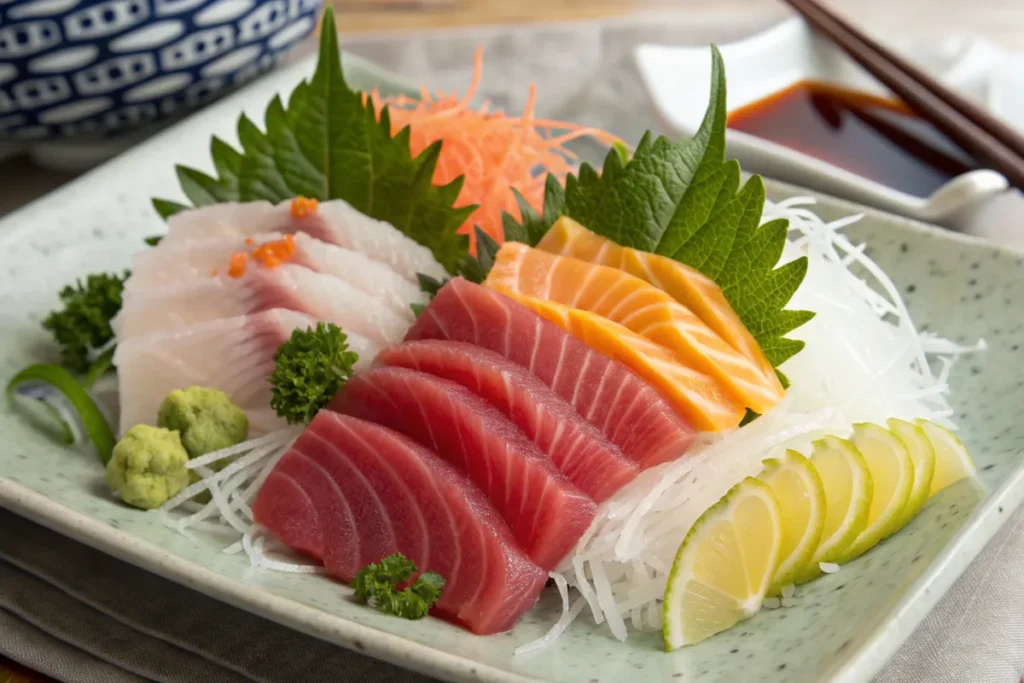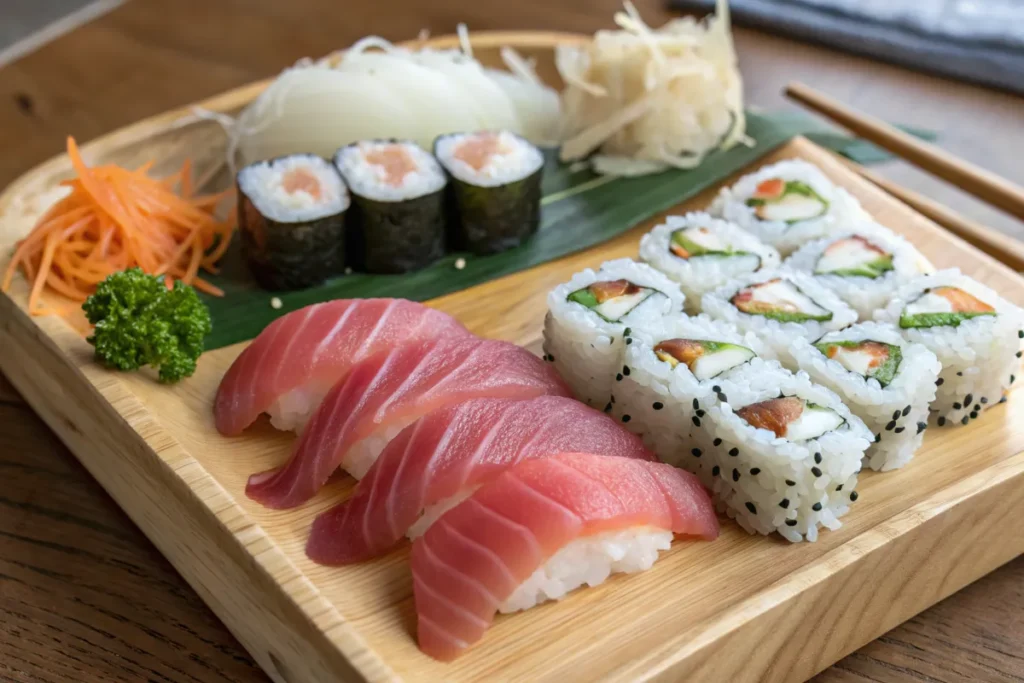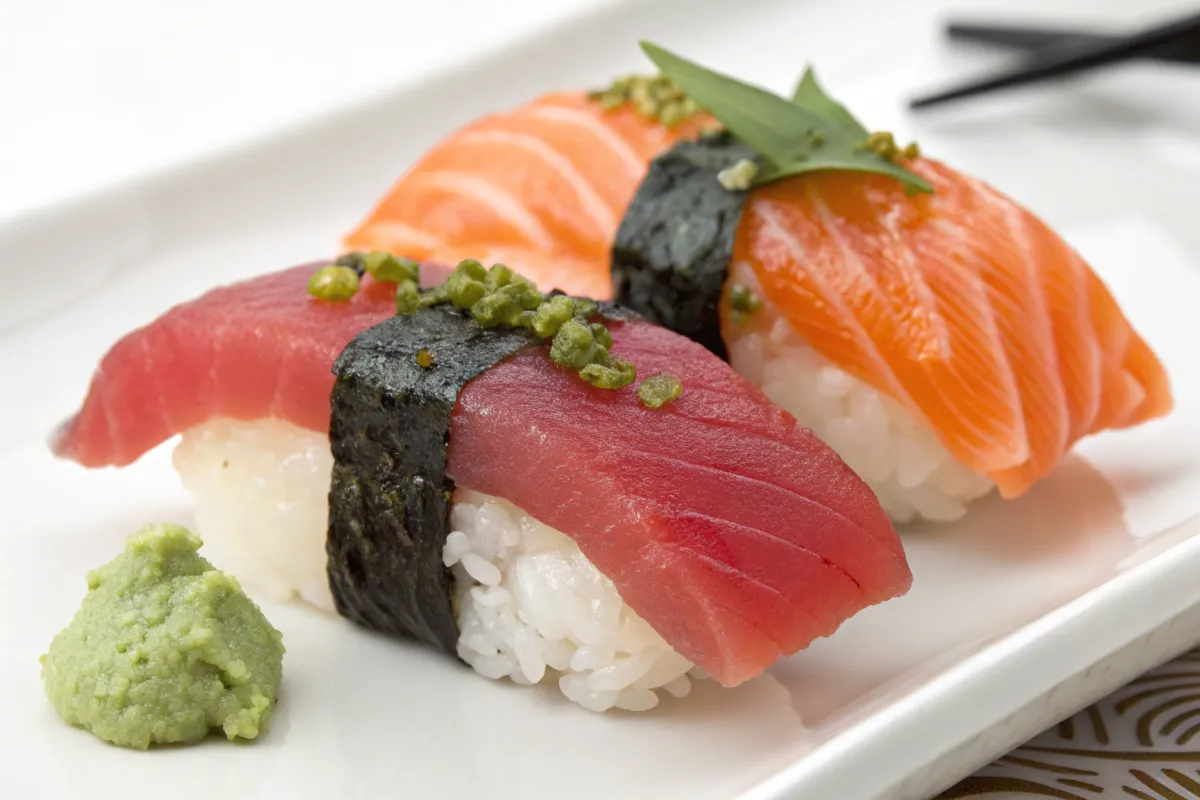Written by Sarah Miller
When it comes to Japanese cuisine, sushi often takes center stage. Two of the most popular sushi options—nigiri and sashimi—are favorites among seafood enthusiasts, but they’re often confused with each other. While both feature high-quality raw fish, their preparation, presentation, and dining experience are distinctly different.
Nigiri is a type of sushi that combines sliced fish with vinegared rice, often topped with garnishes or sauces. Sashimi, on the other hand, focuses solely on the raw fish, served without rice to highlight its pure flavors and textures.
Understanding the differences between these two dishes can enhance your dining experience and deepen your appreciation for the artistry of Japanese cuisine. Whether you’re new to sushi or a seasoned fan, this guide will break down nigiri vs sashimi, exploring their key differences, similarities, and tips for enjoying both.
What Is Nigiri?
Nigiri is a traditional Japanese dish that combines fresh seafood with a small mound of vinegared rice. It’s one of the most iconic types of sushi and is often served in pairs as part of a sushi platter. The term “nigiri” comes from the Japanese word nigiru, meaning “to grasp,” referring to the hand-shaped rice base that supports the fish.
Ingredients in Nigiri
Nigiri’s simplicity highlights the quality of its ingredients. Each piece typically includes:
- Rice: Short-grain white rice seasoned with rice vinegar, sugar, and salt. The rice is shaped into an oblong mound by hand.
- Fish or Seafood: A thin slice of raw fish or seafood, such as tuna, salmon, shrimp, or eel, placed on top of the rice.
- Toppings (Optional): Wasabi, a thin strip of nori (seaweed), or garnishes like scallions, sesame seeds, or a citrus zest.
How Nigiri Is Prepared
- Rice Preparation: The rice is cooked and seasoned with a mixture of rice vinegar, sugar, and salt, then cooled to room temperature.
- Shaping the Rice: Chefs shape a small amount of rice into a compact oblong form using their hands.
- Adding Wasabi: A small dab of wasabi is often applied to the rice to enhance the flavor.
- Placing the Fish: A slice of fresh fish or seafood is layered over the rice. Some chefs add a thin strip of nori to hold the fish and rice together.
Why Nigiri Is Special
Nigiri showcases the perfect balance between fish and rice. The rice provides a mild, tangy base that complements the fish’s natural flavors. It’s an approachable option for sushi beginners because of its simplicity and the familiarity of rice.
Looking for more seafood insights? Check out this guide to Salmon Roe to expand your knowledge of Japanese delicacies.
What Is Sashimi?
Sashimi is a Japanese delicacy consisting of thinly sliced raw fish or seafood, served without rice or other accompaniments. The word “sashimi” translates to “pierced body,” reflecting the traditional method of preparing fish. Unlike sushi, which often includes rice and other components, sashimi focuses solely on the purity and quality of the seafood itself.

Nigiri vs. Sashimi Ingredients
Ingredients in Sashimi
The simplicity of sashimi allows the natural flavors and textures of the fish to shine. Common ingredients include:
- Fish or Seafood: Tuna, salmon, yellowtail, mackerel, squid, or scallops are popular choices.
- Garnishes: Often accompanied by shredded daikon radish, shiso leaves, or edible flowers for presentation.
- Condiments: Typically served with soy sauce, wasabi, and pickled ginger for dipping and cleansing the palate.
How Sashimi Is Prepared
- Fish Selection: Only the highest quality fish, often labeled as “sushi-grade” or “sashimi-grade,” is used to ensure safety and flavor.
- Expert Cutting: Chefs use precise knife techniques to slice the fish into delicate pieces, with different cuts offering unique textures.
- Presentation: Each slice is carefully arranged on a plate with garnishes, emphasizing aesthetics and balance.
Why Sashimi Is Special
Sashimi is revered for its ability to highlight the pure essence of seafood. Each bite offers a unique experience, from the buttery smoothness of salmon to the firm yet tender texture of tuna. The dish is a favorite among seafood connoisseurs who appreciate the craftsmanship and freshness that go into its preparation.
Popular Sashimi Types
| Type | Description | Texture |
|---|---|---|
| Maguro (Tuna) | Rich and flavorful, with a firm, meaty texture. | Firm and smooth |
| Sake (Salmon) | Buttery and mild, often with a marbled appearance. | Soft and buttery |
| Hamachi (Yellowtail) | Slightly sweet with a delicate, creamy flavor. | Tender and silky |
| Hotate (Scallops) | Sweet and mild, often with a subtle chewiness. | Soft and delicate |
| Ika (Squid) | Mildly sweet with a slightly chewy texture. | Firm and chewy |
Sashimi is often the highlight of omakase menus, where chefs choose the freshest cuts of the day. Want to learn about more Japanese seafood dishes? Check out this Weight Watchers Sushi Guide for healthy sushi options.
Nigiri vs. Sashimi: Key Differences
Nigiri and sashimi are staples of Japanese cuisine, but they differ in ingredients, preparation, and presentation. Let’s break down the key differences between these two beloved dishes.
Ingredients and Preparation
- Nigiri: Combines raw fish or seafood with a small mound of vinegared rice. The rice is shaped by hand, and a slice of fish is placed on top, sometimes with wasabi or a strip of nori to hold it together.
- Sashimi: Consists solely of thinly sliced raw fish or seafood, served without rice. The focus is on the freshness and quality of the seafood.
Presentation and Serving Style
- Nigiri: Presented as individual pieces, often paired with soy sauce and pickled ginger. Its simplicity highlights the balance between fish and rice.
- Sashimi: Typically served as an elegant arrangement of sliced fish on a plate with garnishes like shredded daikon, shiso leaves, and edible flowers.
Dining Experience
- Nigiri: Offers a combination of textures, with the soft fish contrasting the slightly firm vinegared rice. It’s filling and approachable for sushi beginners.
- Sashimi: Focuses entirely on the taste and texture of the fish, offering a purer and more refined seafood experience. It’s ideal for those who want to savor the raw fish itself.
Nigiri vs Sashimi Comparison Table
| Feature | Nigiri | Sashimi |
|---|---|---|
| Ingredients | Raw fish + vinegared rice | Raw fish or seafood only |
| Presentation | Fish on rice, served in pairs | Sliced fish arranged on a plate |
| Serving Style | Paired with soy sauce and ginger | Accompanied by garnishes and wasabi |
| Texture | Combination of soft fish and rice | Pure texture of raw fish |
| Best For | Sushi beginners | Seafood connoisseurs |
Nigiri offers a balance of flavors and textures, while sashimi showcases the seafood’s purity. Both are essential experiences for any sushi lover.

Nigiri vs Sashimi: Similarities
Despite their differences, nigiri and sashimi share several similarities, reflecting their roots in traditional Japanese cuisine.
1. Emphasis on Fresh Seafood
Both nigiri and sashimi prioritize the quality and freshness of the seafood. Sushi-grade or sashimi-grade fish is used to ensure safety and enhance the dining experience.
2. Simple Ingredients
Nigiri and sashimi rely on minimal ingredients, allowing the natural flavors of the seafood to shine. Whether served with rice or on its own, the fish remains the centerpiece.
3. Accompaniments
Traditional condiments like soy sauce, wasabi, and pickled ginger are common to both dishes. These enhance the flavors without overpowering the delicate taste of the fish.
4. Presentation as an Art Form
Both dishes are presented with attention to detail, often arranged elegantly to reflect Japanese culinary artistry. Chefs may use garnishes like shiso leaves, daikon radish, or citrus zest for added flair.
5. Versatility
Nigiri and sashimi can be made with a variety of seafood, including tuna, salmon, yellowtail, shrimp, and scallops, making them adaptable to different tastes.
Nigiri and sashimi are more than just food—they’re an experience. Their shared focus on freshness and simplicity makes them iconic in Japanese dining.
Nigiri vs Sashimi: How to Enjoy
Whether you’re dining at a sushi bar or enjoying these dishes at home, knowing the proper way to eat and pair nigiri and sashimi can enhance your experience.
1. Traditional Condiments
- Soy Sauce: Lightly dip the fish side of nigiri or sashimi into soy sauce. Avoid soaking it, as this can overpower the delicate flavors.
- Wasabi: A small amount can be placed on top of sashimi or added to soy sauce for a spicier dip. For nigiri, wasabi is often already added between the fish and rice.
- Pickled Ginger: Use as a palate cleanser between bites, not as a topping.
2. Proper Etiquette
- For Nigiri: Pick it up with chopsticks or your fingers. Dip only the fish side into soy sauce to prevent the rice from falling apart.
- For Sashimi: Use chopsticks to handle the slices, dipping them lightly into soy sauce as desired.
3. Best Pairings
Pairing nigiri and sashimi with complementary drinks and sides can elevate your meal:
- Drinks:
- Sake: A classic choice that complements the umami flavors of the seafood.
- Green Tea: Cleanses the palate and pairs well with the lightness of the dishes.
- Sides:
- Miso Soup: A warm and comforting addition.
- Seaweed Salad: Adds a refreshing, slightly tangy element.
- Rice: Steamed rice can balance the richness of sashimi if served as a main dish.
4. Experiment with Flavors
While traditional condiments are common, many sushi chefs create unique toppings or sauces for nigiri and sashimi. Don’t hesitate to try combinations like ponzu sauce, yuzu zest, or sesame oil.
Enjoying nigiri and sashimi is not just about eating—it’s about savoring the craftsmanship and fresh ingredients.
Nigiri vs Sashimi: Variations
Both nigiri and sashimi offer opportunities for creativity and personalization. From modern twists to traditional regional styles, there are many ways to enjoy these iconic dishes.
1. Creative Nigiri Toppings
While traditional nigiri features raw fish, chefs often experiment with toppings to enhance flavor and presentation:
- Torched Salmon (Aburi): Lightly seared salmon adds a smoky, buttery flavor.
- Scallop with Citrus: A slice of fresh scallop paired with a drizzle of yuzu or lemon juice.
- Eel (Unagi): Grilled eel brushed with a sweet soy glaze.
- Uni (Sea Urchin): A creamy, briny delicacy often placed atop rice for a luxurious treat.
- Ikura (Salmon Roe): Bright, salty salmon eggs served as a topping or garnish.
2. Unique Sashimi Cuts
The way fish is sliced for sashimi can influence its texture and flavor:
- Hira-zukuri: The standard rectangular cut, thick enough to highlight the fish’s natural texture.
- Usu-zukuri: Paper-thin slices, often used for delicate fish like flounder.
- Kaku-zukuri: Cubed cuts, offering a firmer bite, typically used for tuna or salmon.
- Ito-zukuri: Thin, julienne-style cuts, ideal for pairing with sauces or garnishes.
3. Regional and Modern Styles
Both dishes have evolved over time, with chefs introducing innovative styles:
- Modern Nigiri: Incorporates fusion elements like truffle oil, foie gras, or chili flakes.
- Sashimi Platters: Elaborate arrangements with a mix of fish, seafood, and edible garnishes for visual appeal.
- Omakase Experiences: A chef-curated selection showcasing the freshest seasonal ingredients.
4. Mini Nigiri and Sashimi
Perfect for parties or tasting menus, smaller portions make these dishes approachable and fun to eat.
Nigiri and sashimi’s adaptability makes them a playground for creativity, blending tradition with modern flair.
Health Benefits of Nigiri and Sashimi
Both nigiri and sashimi are not only delicious but also packed with nutrients that contribute to a healthy diet. Their focus on fresh, high-quality seafood makes them excellent sources of protein, omega-3 fatty acids, and essential vitamins.
1. High in Protein
- Nigiri: Combines lean protein from fish with carbohydrates from rice, making it a balanced option for energy and muscle repair.
- Sashimi: Pure protein with minimal calories, perfect for those following low-carb or high-protein diets.
2. Rich in Omega-3 Fatty Acids
The fish used in nigiri and sashimi—like salmon, tuna, and mackerel—is rich in omega-3s, which:
- Support heart health.
- Reduce inflammation.
- Improve brain function.
3. Packed with Essential Vitamins and Minerals
- Vitamin D: Found in fatty fish like salmon, supports bone health and immunity.
- Vitamin B12: Vital for red blood cell production and energy metabolism.
- Iodine: Promotes thyroid function, especially in seafood like shrimp and scallops.
4. Low in Calories
- Nigiri: A single piece averages 40–50 calories, depending on the type of fish.
- Sashimi: Even lower in calories, making it an excellent choice for weight-conscious individuals.
5. Great for Digestion
Both dishes are light and easy to digest, especially when paired with gut-friendly condiments like pickled ginger and wasabi, which have natural antibacterial properties.
Nutrition Comparison Table
| Nutrient | Nigiri (Per Piece) | Sashimi (Per Slice) |
|---|---|---|
| Protein | 3–4 g | 5–6 g |
| Calories | 40–50 | 20–30 |
| Omega-3s | High | High |
| Carbohydrates | 6–8 g (from rice) | None |
| Fat | 0.5–2 g | 1–3 g |
Eating nigiri and sashimi is not just a flavorful experience—it’s also a smart choice for a nutrient-dense meal.
FAQs
What is the difference between nigiri and sashimi?
The main difference lies in their preparation and presentation:u003cbru003eu003cstrongu003eNigiri:u003c/strongu003e A slice of fish or seafood placed atop a small mound of vinegared rice, sometimes garnished with wasabi or nori.u003cbru003eu003cstrongu003eSashimi:u003c/strongu003e Thin slices of raw fish or seafood served without rice, often accompanied by garnishes like daikon radish or shiso leaves.u003cbru003eNigiri incorporates rice, making it more filling, while sashimi focuses solely on the quality and flavor of the fish.
u003ca href=u0022https://momtasty.com/?s=Sashimiu0022u003eWhy is sashimi more expensive than nigiri?u003c/au003e
Sashimi is typically more expensive because it uses higher-grade fish and larger portions. Since sashimi showcases the pure flavor and texture of the fish, only the freshest and most premium cuts are used, often requiring more skill and effort in preparation.
What are the three main types of sushi?
u003cstrongu003eNigiri:u003c/strongu003e Fish or seafood served atop vinegared rice.u003cbru003eu003cstrongu003eMaki:u003c/strongu003e Sushi rolls made with fish, vegetables, and rice, wrapped in seaweed (nori).u003cbru003eu003cstrongu003eSashimi:u003c/strongu003e Thin slices of raw fish or seafood served without rice.u003cbru003eEach type offers a unique experience and caters to different preferences.
Is nigiri eaten in one bite?
Yes, nigiri is traditionally eaten in one bite. This allows you to enjoy the perfect balance of fish and rice in a single mouthful, as intended by the chef. If a piece is too large, it’s polite to eat it in two bites while keeping the components intact.
How many nigiri per person?
The typical serving size is u003cstrongu003e6–8 pieces of nigiri per personu003c/strongu003e for a meal, depending on appetite and whether it’s part of a larger sushi platter. For appetizers, 2–3 pieces per person is common.
Is nigiri always raw?
No, nigiri is not always raw. While raw fish is traditional, some nigiri features cooked or grilled seafood, such as:u003cbru003eu003cstrongu003eUnagi (Eel):u003c/strongu003e Grilled and brushed with a sweet soy glaze.u003cbru003eu003cstrongu003eEbi (Shrimp):u003c/strongu003e Typically boiled or steamed.u003cbru003eu003cstrongu003eTamago (Egg):u003c/strongu003e A sweet Japanese omelet served on rice.u003cbru003eThese variations make nigiri accessible to those who may not prefer raw fish.
Conclusion
Nigiri and sashimi are two iconic staples of Japanese cuisine, each offering unique flavors, textures, and experiences. While nigiri combines vinegared rice and fresh seafood for a balanced bite, sashimi focuses purely on the fish, highlighting its natural taste and quality.
Whether you’re a sushi beginner or a seasoned enthusiast, understanding the differences between nigiri vs sashimi can deepen your appreciation for these dishes. With their emphasis on fresh, high-quality ingredients and artistic presentation, both options showcase the beauty of simplicity in Japanese culinary traditions.
Next time you’re at a sushi bar or making these dishes at home, remember to savor the craftsmanship, pair them with traditional condiments, and try creative variations to explore new flavors.

Nigiri and Sashimi
Ingredients
For Nigiri
- 2 cups Short-grain white rice Seasoned with rice vinegar, sugar, and salt
- 8 oz Raw fish (e.g., tuna, salmon, shrimp, eel) Thinly sliced
- 1 tbsp Wasabi Optional, for flavor enhancement
- 1 sheet Nori (seaweed) Optional, for holding fish and rice together
- 2 tbsp Scallions Optional topping
- 1 tbsp Sesame seeds Optional topping
- 1 tbsp Citrus zest Optional topping
For Sashimi
- 8 oz Sashimi-grade fish (e.g., maguro, sake, hamachi) Thinly sliced
- 1 cup Shredded daikon radish For garnish
- 1 leaf Shiso leaves For garnish
- 2 tbsp Soy sauce For dipping
- 1 tbsp Pickled ginger For palate cleansing
Instructions
Preparation for Nigiri
- Cook the short-grain white rice according to package instructions.
- Season the cooked rice with rice vinegar, sugar, and salt, then let it cool to room temperature.
- Shape a small amount of cooled rice into a compact oblong shape with your hands.
- Dab a small amount of wasabi onto the rice.
- Place a slice of fresh fish on top of the rice. Optionally, wrap a thin strip of nori around it.
Preparation for Sashimi
- Select only high-quality, sushi-grade fish.
- Using a sharp knife, slice the fish into thin, delicate pieces.
- Arrange the sliced fish elegantly on a plate, adding garnishes like shredded daikon and shiso leaves.
- Serve with soy sauce and pickled ginger on the side.
